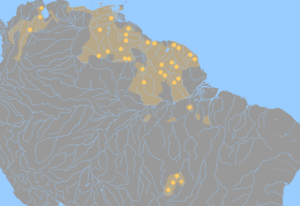| Cariban | |
|---|---|
| Geographic distribution | Mostly within north-central South America, with extensions in the southern Caribbean and in Central America. |
| Linguistic classification | Je–Tupi–Carib?
|
| Language codes | |
| Glottolog | cari1283 |
 Present location of Cariban languages, c. 2000, and probable extent in the 16th century. | |
The Cariban languages are a family of languages indigenous to north-eastern South America. They are widespread across northernmost South America, from the mouth of the Amazon River to the Colombian Andes, and they are also spoken in small pockets of central Brazil. The languages of the Cariban family are relatively closely related. There are about three dozen, but most are spoken only by a few hundred people. Macushi is the only language among them with numerous speakers, estimated at 30,000. The Cariban family is well known among linguists partly because one language in the family—Hixkaryana—has a default word order of object–verb–subject. Prior to their discovery of this, linguists believed that this order did not exist in any spoken natural language.
In the 16th century, Cariban peoples expanded into the Lesser Antilles. There they killed or displaced, and also mixed with the Arawak peoples who already inhabited the islands. The resulting language—Kalhíphona or Island Carib—was Carib in name but largely Arawak in substance. The Carib male conquerors took Arawak women as wives, and the latter passed on their own language on to the children. For a time, Arawak was spoken by women and children and Carib by adult men, but as each generation of Carib-Arawak boys reached adulthood, they acquired less Carib until only basic vocabulary and a few grammatical elements were left. That form of Island Carib became extinct in the Lesser Antilles in the 1920s, but it survives as Garífuna, or "Black Carib," in Central America. The gender distinction has dwindled to only a handful of words. Dominica is the only island in the eastern Caribbean to retain some of its pre-Columbian population, descendants of the Carib Indians, about 3,000 of whom live on the island's east coast.